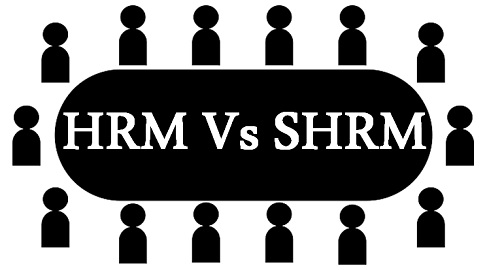The term HRM expands to Human Resource Management; it implies the implementation of management principles for managing the workforce of an organisation. It is concerned with the process of hiring, developing and retaining the manpower, with a view to making them more efficient. When conventional HRM is compared and contrasted with the strategic HRM or SHRM, it becomes easier to understand.
SHRM is the process of aligning the business strategy with the company’s human resource practices, so as to attain strategic goals of an organization. In SHRM, the workforce of the company is managed proactively. Take a glance at the article presented here that explains the difference between HRM and SHRM.
Comparison Chart
| BASIS FOR COMPARISON | HRM | SHRM |
| Meaning | Human resource management (HRM) implies the governance of manpower of the organization in a thorough and structured manner. | SHRM is a managerial function which implies framing of HR strategies in such a way to direct employees efforts towards the goals of the organization. |
| Nature | Reactive | Proactive |
| Responsibility lies with | Staff specialist | Line manager |
| Approach | Fragmented | Integrated |
| Scope | Concerned with employee relations | Concerned with internal and external relations |
| Time horizon | Short term | Long term |
| Basic factor | Capital and products | People and knowledge |
| Change | Follows change | Initiates change |
| Accountability | Cost center | Investment center |
| Control | Stringent control over employees | It exhibits leniency. |
Definition of HRM
Human Resource Management or HRM is simply the process of managing human resources, in a systematic way. It is a practice devised to maximize the performance of employees, i.e. to make them more efficient and productive. It is concerned with the application of principles of management to manage organisation personnel while paying attention to the policies and systems of the entity. It entails the best possible use of limited skilled workforce of the organisation.
Read More: Difference Between Personnel Management and Human Resource Management
HRM consist of human-oriented activities like recruiting, training and development, performance appraisal, safety and health, industrial relations and so on. It facilitates adjusting human resource policies and practices with the strategies of the organization, whether corporate or functional.
The functions of a human resource manager include planning, staffing, developing, maintaining, monitoring, managing relationships, evaluating, managing change, etc.
Definition of SHRM
Strategic Human Resource Management, shortly known as SHRM is a function of management which entails development of policies, programmers and practices related to human resources, which are then aligned with business strategy, so as to achieve strategic objectives of the organisation. Its primary purpose is to improve the performance of the business and maintain a culture that encourages innovation and works continuously to gain competitive advantage.
The aim of SHRM is that companies must adjust their HR strategy within the periphery of overall business objectives, thus ensuring that HR practices are in tune with the strategic objectives of the organization. It lays down a clear corporate strategy and vision for future. A major pro of strategic human resource management is that it ascertains and analyses external opportunities and threats to the business organisation.
Differences Between HRM and SHRM
The differences between HRM and SHRM can be drawn clearly on the following grounds:
- The governance of manpower of the organisation in a thorough and structured manner is called Human Resource Management or HRM. A managerial function which implies framing of HR strategies in such a way to direct employees efforts towards the goals of an organisation is known as SHRM.
- The process of HRM is reactive in nature. On the other hand, SHRM is a proactive management function.
- In human resource management, the responsibility of manpower lies with the staff specialists, whereas in strategic human resource management, the task of managing the workforce, is vested in the line managers.
- HRM follows fragmented approach, which stresses on applying management principles while managing people in an organisation. As against this, SHRM follows an integrated approach, which involves lining up of business strategy with the company’s HR practices.
- Human resource management emphasises on employee relations, ensuring employees motivation, and also the firm conforms to the necessary employment laws. Conversely, SHRM focuses on a partnership with internal and external constituent groups.
- HRM supports short-term business goals and outcomes, but SHRM supports long-term goals and results of business.
- In human resource management, the human resource manager plays the role of change follower, i.e. he/she responses to change, hence pursues transactional leadership style. As opposed to SHRM, the human resource manager is a change leader, i.e. an imitator, thus seeks transformational leadership.
- The primary element in HRM is the capital and products, but people and their knowledge are the building blocks of SHRM.
- If we talk about accountability, a conventional HRM is a cost centre. Unlike a strategic HRM which is an investment centre.
- In human resource management, stringent control over employees is exercised. As against this, in strategic human resource management, no such control is imposed, rather the rules for managing manpower is lenient.





